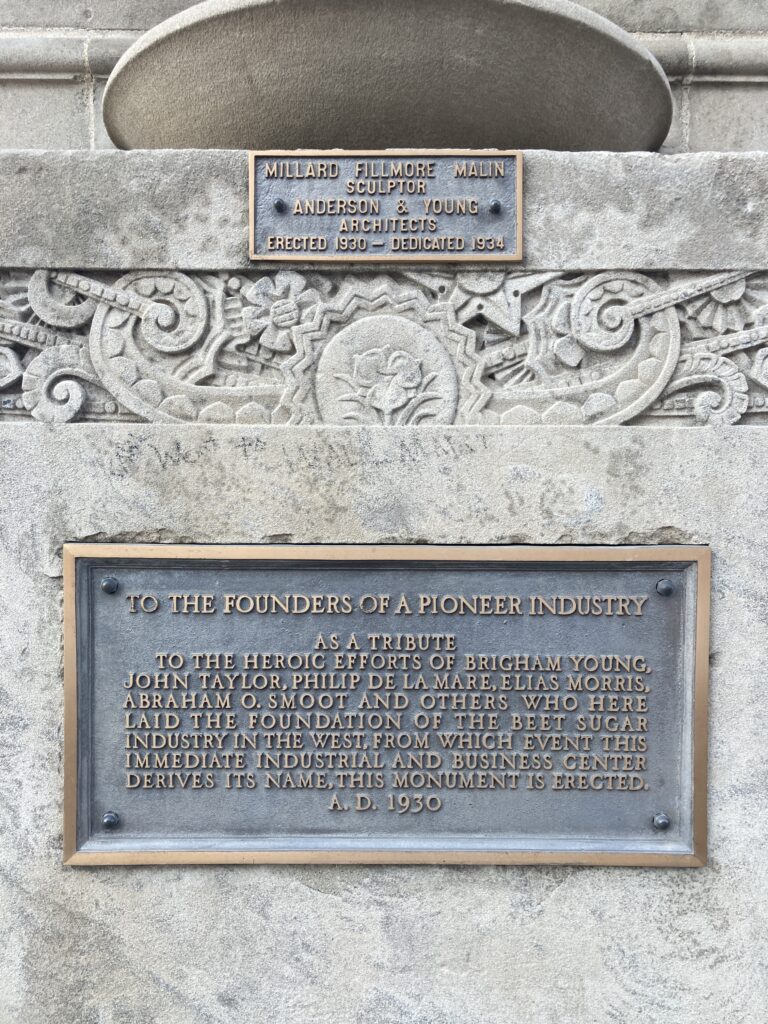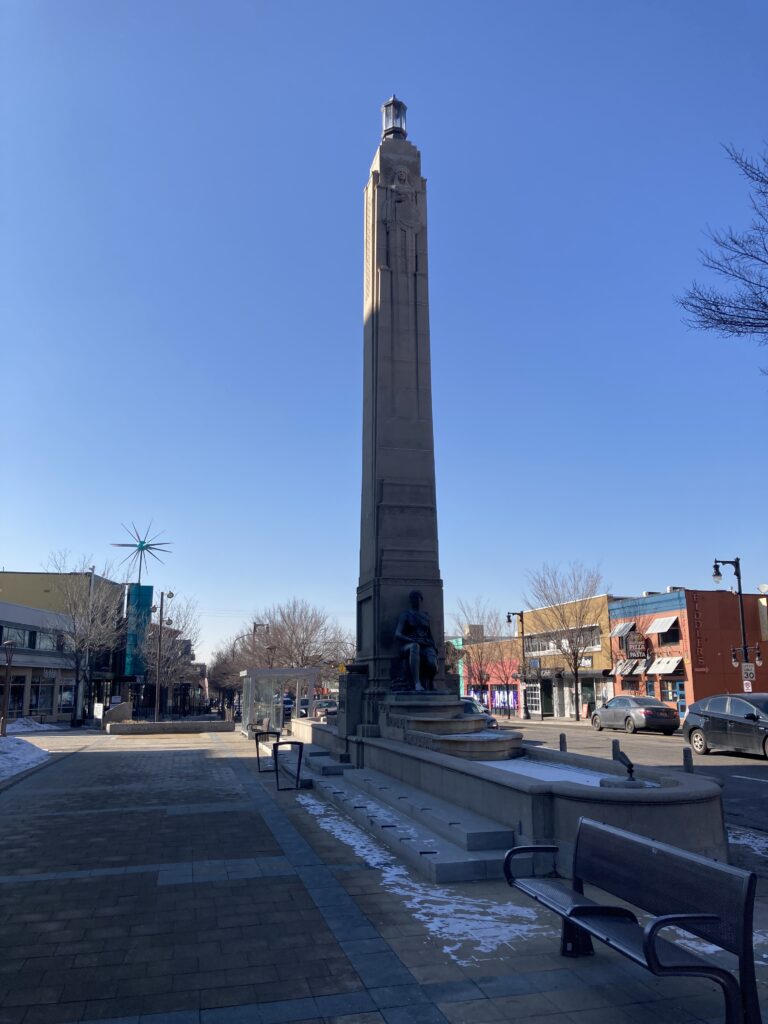Write-up by Jordan Nelson
Placed by: Anderson & Young Architects, Sugarhouse Business Men’s League
GPS Coordinates: 40° 43′ 31″ N, 111° 51′ 36″ W
Historical Marker Text (1):
To the founders of a pioneer industry As a tribute
to the heroic efforts of Brigham Young, John Taylor, Philip De La Mare, Elias Morris,
Abraham O. Smoot and other who here laid the foundation of the beet sugar
industry in the west, from which event this immediate industrial and business center
derives its name, this monument is erected A.D. 1930
Historical Marker Text (2):
Erected in recognition of the first effort made to manufacture Beet sugar in western America. With dauntless perseverance through severe hardships the machinery was brought from Liverpool, ENG. to this place, where in 1853 the sugar mill was constructed.
may the spirit of this courageous venture
continue to characterize this community.
The Old Sugar House
Home of one of the earliest efforts toward the creation of local industry in Utah.
At these crossroads in 1853-55, a structure was erected which stood for many years as a symbol
of pioneer enterprise and courage. Its site was approximately two hundred feet east of this spot.
After the sugar project was abandoned the old mill served many other useful purposes. Its life ended in 1928.
Extended Research:
After establishing settlements in the late 1840s within the Salt Lake valley, Brigham Young was well aware that importing resources for his fledgling state was a strain on the Church’s economic reserves. Shipping sugar was especially a burden on the economics of the region, accountants within church leadership calculated that if all sugar needs were imported from outside sources it would cost $240,000 a year.1 In order to meet this demand the territory needed a reliable source of sugar from crops that could grow in the eastern Great Basin. Brigham Young corresponded with John Taylor, a church leader serving a mission in France in late 1850. Taylor contacted various engineers there who were well acquainted with the process of extracting sugar from beets. John Taylor on Brigham Young’s order established the Deseret Manufacturing Company and purchased more than a thousand pounds of French beet seeds along with the machinery to process the beets into sugar from Liverpool. It seemed that this new industry for Brigham’s kingdom was on its way to success. All of those involved would not see the troubles that lay ahead for them.1
At almost every part of the journey from France, the company encountered problem after problem. The problems ranged from: paying surprise shipping fees in New Orleans, buying sturdier wagons to carry the machinery to Salt Lake, the cattle getting loose or dying on the trail, and finally an early winter which halted the progress of the heaviest and most crucial parts of the machine.1 The machinery was still stuck in the mountains by the end of February 1853 with Brigham Young writing to Samuel Richards, a prominent church leader on a mission in England, that some mail carriers had left parcels that they couldn’t carry in the boilers so that they would be protected through the rest of the severe winter.2
While waiting to retrieve the parts, the Deseret Manufacturing Company established a site in Provo to experiment in refining the beet crop. Multiple failures influenced Brigham Young to relieve John Taylor as head of the DMC. The machinery was retrieved from the mountain pass after winter ended and moved to its eventual spot, current day Sugar House. But even with the move and the machine assembled the attempts to create sugar from beet juice only produced “an inedible molasses.”3 These failed attempts were due to the workers’ “complete lack of knowledge” about the sugar distillation process or even the proper construction of the building.4 The failure had reflected other setbacks in early Mormon industry but the sugar beet loss cost the Church over $100,000 in total. While this was a great setback the industrial drive of the Mormons continued on into the 1890’s when sugar from sugar beets was finally successful in Lehi. This was in part because sugar manufacturing from beets succeeded in California in 1879, which allowed for the knowhow to then trickle throughout the United States.5
The Sugar House Monument was first suggested by Millard Malin, a sculptor, to the Sugar House Business Men’s League in 1928. During this time the city was in a period of beautification and Malin suggested that a monument in Sugar House plaza would be a good way to memorialize “early Utah industry.”6 This idea was also reflected by LDS Church leaders at the time, who viewed the failures of the Sugar House mill as only a step to the eventual establishment of the sugar industry in Utah.7
1 Leonard Arrington, Great Basin Kingdom: An Economic History of the Latter-day Saints, 1830–1900 (Cambridge, Massachusetts: Harvard University Press, 1958), 116-120.
2 Young, Brigham. Letter to Samuel W Richards. 27 February 1853. L. Tom Perry Special Collections.
3 Woodger, Mary Jane, “Bitter Sweet: John Taylor’s Introduction of the Sugar Beet Industry in Deseret” Utah Historical Quarterly 69:3, 2001.
4 Matthew C Godfrey. Religion, Politics, and Sugar: The Mormon Church, the Federal Government, and the Utah-Idaho Sugar Company, 1907 to 1921. Logan: Utah State University Press, 2007.
5 Mary Jane Woodger, “Bitter Sweet,” 262.
6 United States Department of the Interior & National Park Service, National Register of Historic Places Continuation Sheet. OMB No. 1024-0018. July 11, 2003.
7 Mary Jane Woodger, “Bitter Sweet,” 263.
For Further Reference:
Primary Sources
Young, Brigham. Letter to Samuel W Richards. 27 February 1853. L. Tom Perry Special Collections.
Secondary Sources
Leonard Arrington, Great Basin Kingdom: An Economic History of the Latter-day Saints 1830–1900, (Cambridge, Massachusetts: Harvard University Press, 1958), 116-120.
United States Department of the Interior & National Park Service, National Register of Historic Places Continuation Sheet. OMB No. 1024-0018. July 11, 2003.
Matthew C Godfrey. Religion, Politics, and Sugar: The Mormon Church, the Federal Government, and the Utah-Idaho Sugar Company, 1907 to 1921. Logan: Utah State University Press, 2007.
Historic Photo Source: https://collections.lib.utah.edu/details?id=444014&facet_format_t=%22image%2Fjpeg%22&q=sugar+house&facet_setname_s=dha_%2A





